Drought and Desertification in Iran
Abstract
1. Introduction
2. Materials and Methods
2.1. Study Area and Database
2.2. Drought Index
- PVIi is the precipitation variability index for year i;
- Pi is the annual precipitation for year i; and
- µ and σ are the mean annual precipitation in a selected period and standard deviation, respectively.
- Extremely dry: P < µ − 2 × σ;
- Dry: µ − 2 × σ < P < µ − σ;
- Normal: µ – σ < P < µ + σ;
- Wet: P > µ + σ
- P is annual precipitation
2.3. Aridity Index
- P is the annual precipitation (mm) and
- T is the annual mean air temperature (°C).
- The type of climate according to the de Martonne aridity index is shown in Table 2.
- Linear regression is also used to compute the magnitude of trends.
3. Results and Discussion
3.1. Drought
3.2. Overexploitation of Groundwater
3.3. Salinization
3.4. Economic and Socio-Political Implications of Desertification
4. Conclusions
- An ecological-economic approach as a basis for ensuring an integrated and coordinated approach to find various policy alternatives;
- A logical balance and management between the needs of society and the exploitation of natural resources;
- Participation of local non-governmental organizations in water-management decisions to achieve sustainable watershed management;
- Investigation of best water supply and storage methods and modified irrigation systems to enhance the water use efficiency;
- Adaptive and proper management frameworks in rural development projects to provide an appropriate basis for accelerating the process of combating desertification;
- Multidisciplinary works to combine modern scientific findings with indigenous knowledge;
- Assessing the opportunities that can be achieved through controlling desertification and land restoration attempts as pilot projects through an optimal policy;
- Improving information for decision-makers about environmental policy and their responsibilities for the monitoring of environmental impacts.
Author Contributions
Funding
Acknowledgments
Conflicts of Interest
References
- Evans, R.D.; Johansen, J.R. Microbiotic crusts and ecosystem processes. Crit. Rev. Plant Sci. 1999, 18, 183–225. [Google Scholar] [CrossRef]
- Barrow, C.J. Environmental Management for Sustainable Development; Routledge: New York, NY, USA, 2006. [Google Scholar]
- UNDP. Iran and UNDP Strengthen Efforts to Combat Desertification. 2017. Available online: http://www.ir.undp.org/content/iran/en/home/presscenter/articles/2017/06/17/iran-and-undp-strengthen-efforts-to-combat-desertification.html (accessed on 17 June 2017).
- Brauch, H.S.; Spring, U. Securitizing the Ground, Grounding Security; UNCCD Issue Paper No. 2; UNCCD: Bonn, Germany, 2009. [Google Scholar]
- Barrow, C.J. Land Degradation: Development and Breakdown of Terrestrial Environments; Cambridge University Press: Cambridge, UK, 1991; p. 295. [Google Scholar]
- Wang, F.; Pan, X.; Wang, D.; Shen, C.; Lu, Q. Combating desertification in China: Past, present and future. Land Use Policy 2013, 31, 311–313. [Google Scholar] [CrossRef]
- Reed, M.S.; Stringer, L.C. Land Degradation, Desertification and Climate Change: Anticipating, Assessing and Adapting to Future Change; Routledge: New York, NY, USA, 2016. [Google Scholar]
- Jafari, R.; Hasheminasab, S. Assessing the effects of dam building on land degradation in central Iran with Landsat LST and LULC time series. Environ. Monit. Assess. 2017, 189, 74. [Google Scholar] [CrossRef]
- Emadodin, I.; Bork, H.R. Degradation of soils as a result of long-term human-induced transformation of the environment in Iran: An overview. J. Land Use Sci. 2012, 7, 203–219. [Google Scholar] [CrossRef]
- Jafari, R.; Bakhshandehmehr, L. Quantitative mapping and assessment of environmentally sensitive areas to desertification in central Iran. Land Degrad. Dev. 2013. [Google Scholar] [CrossRef]
- Amiraslani, F.; Dragovich, D. Combating desertification in Iran over the last 50 years: An overview of changing approaches. J. Environ. Manag. 2011, 92, 1–13. [Google Scholar] [CrossRef]
- Jafari, M.; Tavili, A.; Panahi, F.; Zandi Esfahan, E.; Ghorbani, M. Reclamation of Arid Lands; Springer International Publishing: Berlin/Heidelberg, Germany, 2018. [Google Scholar] [CrossRef]
- Ekhtesasi, M.R. Investigating Morphometric and Morphodynamic Characteristics of Wind Erosion in Yazd Plain and Determining their Indices for Desertification Models. Ph.D. Thesis, University of Tehran, Tehran, Iran, 2004. [Google Scholar]
- Mishra, A.K.; Singh, V.P. A review of drought concepts. J. Hydrol. 2010, 391, 202–216. [Google Scholar] [CrossRef]
- Agana, N.A.; Homaifar, A. EMD-Based Predictive Deep Belief Network for Time Series Prediction: An Application to Drought Forecasting. J. Hydrol. 2018, 5, 18. [Google Scholar] [CrossRef]
- Ghorbani, M. The Economic Geology of Iran; Springer: Heidelberg, Germany, 2013; pp. 45–65. [Google Scholar] [CrossRef]
- Qadir, M.; Qureshi, A.S.; Cheraghi, S.A.M. Extent and characterization of salt-affected soils in Iran and strategies for their amelioration and management. Land Degrad. Dev. 2008, 19, 214–227. [Google Scholar] [CrossRef]
- Iranian Water Resource Management Company. 2018. Available online: http://wrbs.wrm.ir/SC.php?type=static&id=179 (accessed on 6 August 2019). (In Persian).
- Quiring, S.M. Monitoring Drought: An Evaluation of Meteorological Drought Indices. Geogr. Compass 2009, 3, 64–88. [Google Scholar] [CrossRef]
- Sivandi, A.; Gharehdaghi, H. Performance evaluation of some Metrological Drought Indices in south of khuzestan Province and zoning it using geographic information system (GIS). Indian J. Fundam. Appl. Life Sci. 2014, 4, 730–737. [Google Scholar]
- Gocic, M.; Trajkovic, S. Analysis of precipitation and drought data in Serbia over the period 1980–2010. J. Hydrol. 2013, 494, 32–42. [Google Scholar] [CrossRef]
- Zhang, Y.; Cai, W.; Chen, Q.; Yao, Y.; Liu, K. Analysis of Changes in Precipitation and Drought in Aksu River Basin, Northwest China. Adv. Meteorol. 2015, 4, 1–15. [Google Scholar] [CrossRef]
- Deniz, A.; Toros, H.; Incecik, S. Spatial variations of climate indices in Turkey. Int. J. Climatol. 2011, 31, 394–403. [Google Scholar] [CrossRef]
- De Martonne, E. Aréisme et indice artidite. Comptes Rendus de l’Académie Des Sciences. Paris 1926, 182, 1395–1398. [Google Scholar]
- Guo, Y.; Huang, S.; Huang, Q.; Wang, H.; Fang, W.; Yang, Y.; Wang, L. Assessing socioeconomic drought based on an improved Multivariate. J. Hydrol. 2019, 268, 904–918. [Google Scholar] [CrossRef]
- Trenberth, K.E.; Dai, A.; Van Der Schrier, G.; Jones, P.D.; Barichivich, J.; Briffa, K.R.; Sheffield, J. Global warming and changes in drought. Nat. Clim. Chang. 2014, 4, 17–22. [Google Scholar] [CrossRef]
- Mosley, L.M. Drought impacts on the water quality of freshwater systems; review and integration. Earth Sci. Rev. 2014, 140, 203–214. [Google Scholar] [CrossRef]
- Javari, J. Trend and Homogeneity Analysis of Precipitation in Iran. Climate 2016, 4, 44. [Google Scholar] [CrossRef]
- Dijk, A.I.J.M.; Beck, H.E.; Crosbie, R.S.; Jeu, R.A.M.; Liu, Y.Y.; Podger, G.M.; Timbal, B.; Viney, N.R. The millennium drought in southeast Australia (2001–2009): Natural and human causes and implications for water resources, ecosystems, economy, and society. Water Resour. Res. 2013, 49, 1040–1057. [Google Scholar] [CrossRef]
- Linsley, R.K., Jr.; Kohler, M.A.; Paulhus, J.L.H. Hydrology for Engineers; McGraw-Hill: New York, NY, USA, 1975. [Google Scholar]
- Edwards, B.; Gray, M.; Hunter, B. The Social and Economic Impacts of Drought; CSRM Working Papers; The Australian National University: Melbourne, Australia, 2018; No: 5. [Google Scholar]
- Bodner, G.; Nakhforoosh, A.; Kaul, H.P. Management of crop water under drought: A review. Agron. Sustain Dev. 2015, 35, 401–442. [Google Scholar] [CrossRef]
- Hojjati, M.H.; Boustani, F. An assessment of groundwater crisis in Iran, case study: Fars province. World Acad. Sci. Eng. Technol. 2010, 70, 476–480. [Google Scholar]
- Emadodin, I.; Narita, D.; Bork, H.R. Soil degradation and agricultural sustainability: An overview from Iran. J. Environ. Dev. Sustain. 2012, 14, 611–625. [Google Scholar] [CrossRef]
- Mesgaran, M.B.; Madani, K.; Hashemi, H.; Azadi, P. Iran’s land suitability for agriculture. Sci. Rep. 2017, 7, 7670. [Google Scholar] [CrossRef]
- Wichels, D.; Qadir, M. Achieving sustainable irrigation requires effective management of salts, soil salinity, and shallow groundwater. Agric. Water Manag. 2015, 157, 31–38. [Google Scholar] [CrossRef]
- Kath, J.; Powell, S.; Reardon-Smith, K.; Sawah, S.E.; Jakeman, A.J.; Croke, B.F.W.; Dyer, F.J. Groundwater salinization intensifies drought impacts in forests and reduces refuge capacity. J. Appl. Ecol. 2015, 52, 1116–1125. [Google Scholar] [CrossRef]
- Cheraghi, S.A.M. Institutional and scientific profiles of organizations working on saline agriculture in Iran. In Prospects of Saline Agriculture in the Arabian Peninsula: Proceedings of the International Seminar on Prospects of Saline Agriculture in the GCC Countries 18–20 March 2001, Dubai, United Arab Emirates; Taha, F.K., Ismail, S., Jaradat, A.A., Eds.; Amherst Scientific Publishers: Amherst, MA, USA, 2004; pp. 399–412. [Google Scholar]
- Moameni, A. An appraisal of land resources of Iran; FAO Report: Tehran, Iran, 2004. [Google Scholar]
- Müller, B.; Quaas, M.; Frank, K.; Baumgärtner, S. Pitfalls and Potential of Institutional Change: Rain-Index Insurance and the Sustainability of Rangeland Management; University of Lüneburg Working Paper Series in Economics. No. 149; University of Lüneburg: Lüneburg, Germany, 2009. [Google Scholar]
- Sivakumar, M.V.K.; Stefanski, R. Climate and land degradation—An overview. In Climate and Land Degradation; Springer: Berlin, Heidelberg, 2007; pp. 105–135. [Google Scholar]
- Heath, J.; Binswanger, H.P. Natural resource degradation effects of poverty are largely policy-induced: The case of Colombia. Environ. Dev. Econ. 1996, 1, 65–84. [Google Scholar] [CrossRef]
- Millennium Ecosystem Assessment; Synthesis Report. Chapter 4; World Resources Institute: Washington, DC, USA, 2005; pp. 66–68.
- Wang, F.; Ge, Q.S. Estimation of urbanization bias in observed surface temperature change in China from 1980 to 2009 using satellite land-use data. Chin. Sci. Bull. 2012, 57, 1708–1715. [Google Scholar] [CrossRef]
- Emadodin, I.; Taravat, A.; Rajaei, M. Effects of urban sprawl on local climate: A case study, north central Iran. Urban Clim. 2016, 17, 230–274. [Google Scholar] [CrossRef]
- Emadodin, I.; Reinsch, T. Assessing the impact of land use change on aridification in semi-arid land. Land Degrad. Dev. 2018, 29, 3423–3431. [Google Scholar] [CrossRef]
- Requier-Desjardins, M. Social costs of desertification in Africa: The case of migration. In Future of Drylands; Lee, C., Schaaf, T., Eds.; UNESCO: Paris, France, 2008; pp. 569–581. [Google Scholar]
- Klepp, S. Climate change and migration. In Oxford Research Encyclopedia of Climate Science; Oxford University Press: New York, NY, USA, 2017. [Google Scholar]
- Taravat, A.; Rajaei, M.; Emadodin, I. Urbanization dynamics of Tehran city (1975–2015) using artificial neural networks. J. Maps 2017, 13, 24–30. [Google Scholar] [CrossRef]
- Statistical Centre of Iran. Population Estimation, Country’s Population, Urban and Rural Areas. Available online: https://www.amar.org.ir. 2018 (accessed on 6 August 2019).
- Bahrami, A.; Emadodin, I.; Atashi, M.R.; Bork, H.R. Land-use change and soil degradation: A case study, North of Iran. Agric. Biol. J. N. Am. (ABJNA) 2010, 4, 600–605. [Google Scholar]
- Cleaver, K.M.; Schreiber, G.A. Reversing the Spiral: The Population, Agriculture and Environment Nexus in Sub-Saharan Africa; The World Bank: Washington, DC, USA, 1994. [Google Scholar]
- Madani, K. Water management in Iran: What is causing the looming crisis? J. Environ. Stud. Sci. 2014, 4, 315–328. [Google Scholar] [CrossRef]
- Yao, J.; Zhao, Y.; Yu, X. Spatial-temporal variation and impacts of drought in Xinjiang (Northwest China) during 1961–2015. PeerJ 2018, 6, e4926. [Google Scholar] [CrossRef]
- Wu, H.; Wilhite, D.A. An Operational Agricultural Drought Risk Assessment Model for Nebraska, USA. Natl. Hazards 2004, 33, 1–21. [Google Scholar] [CrossRef]
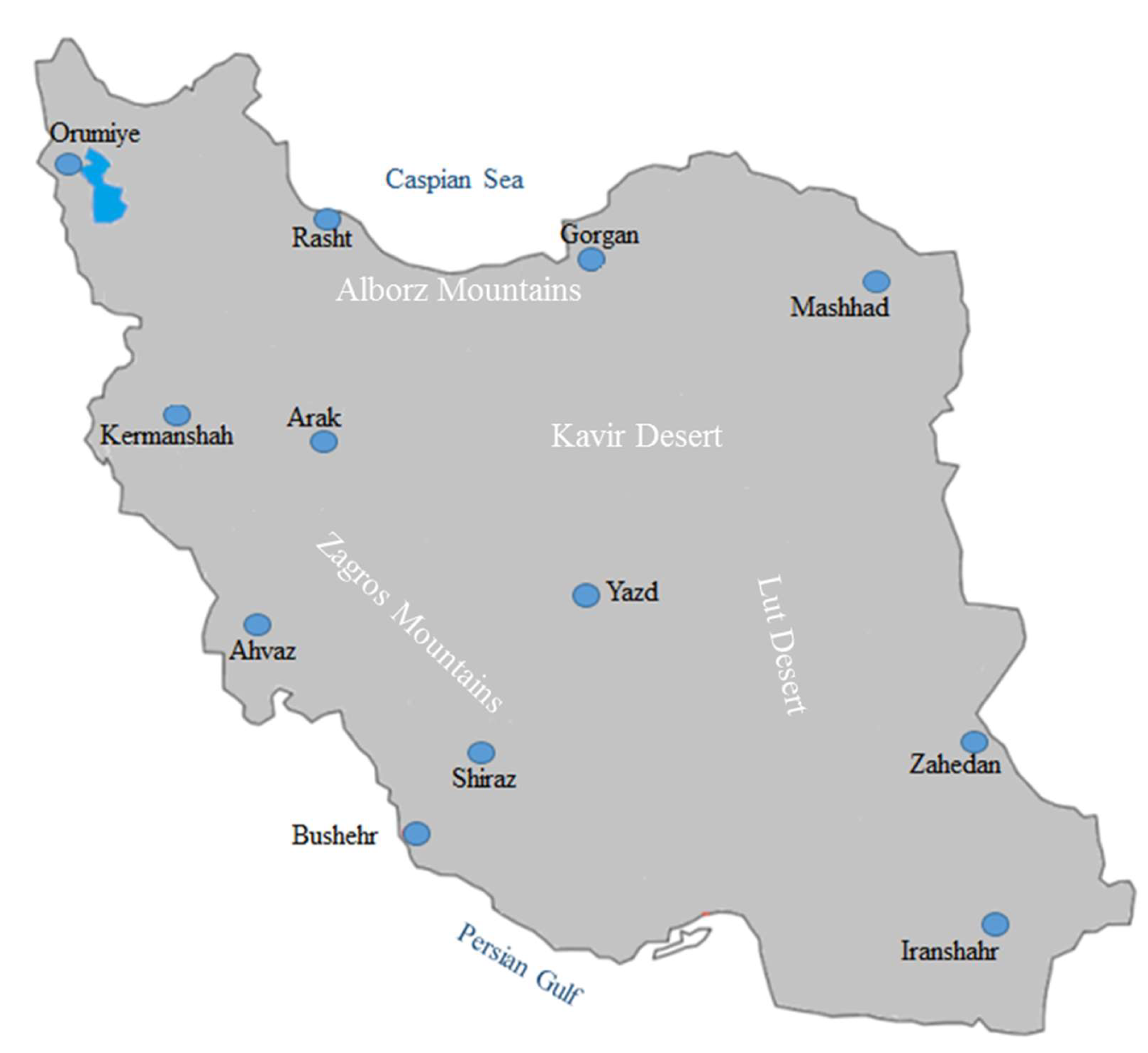
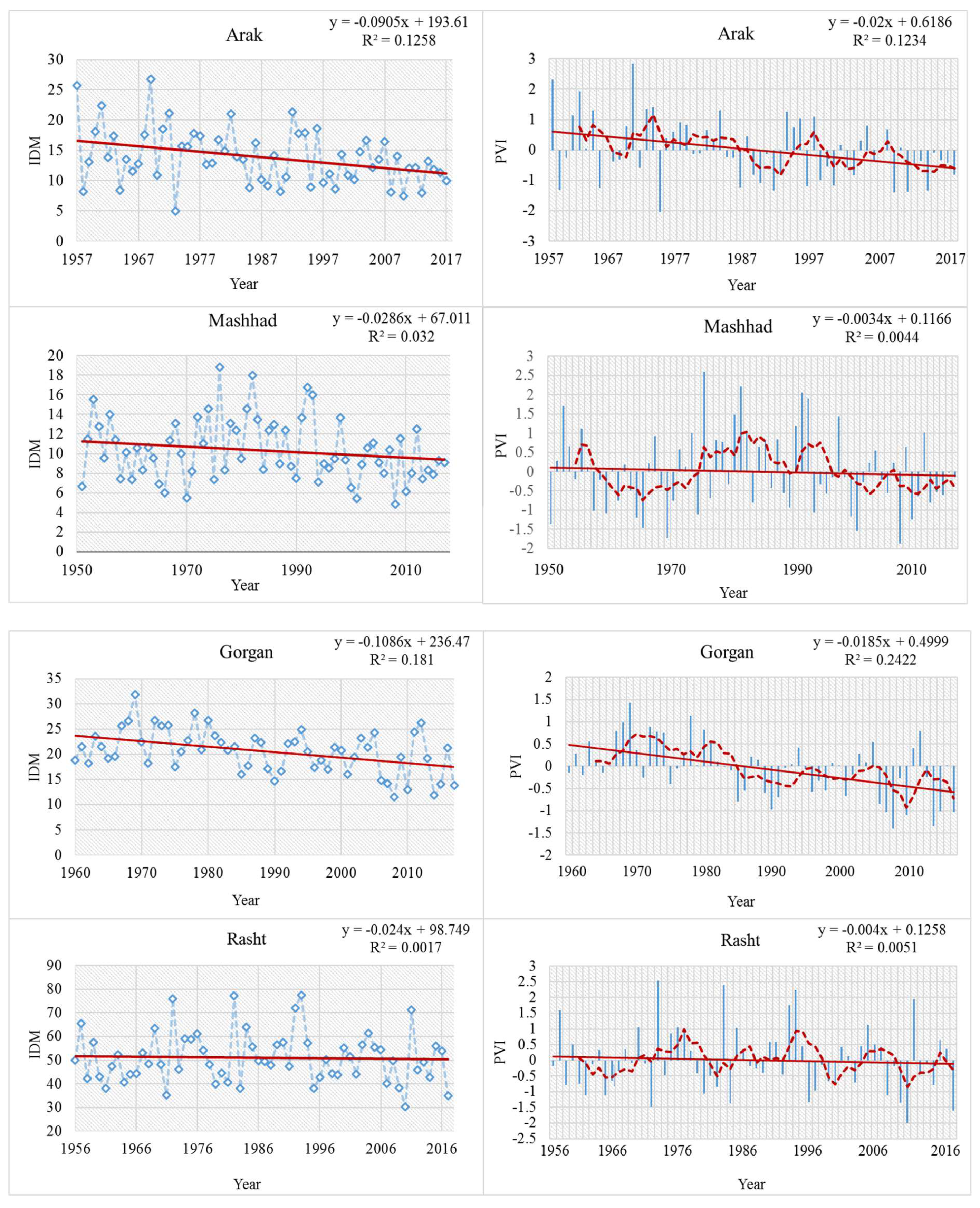
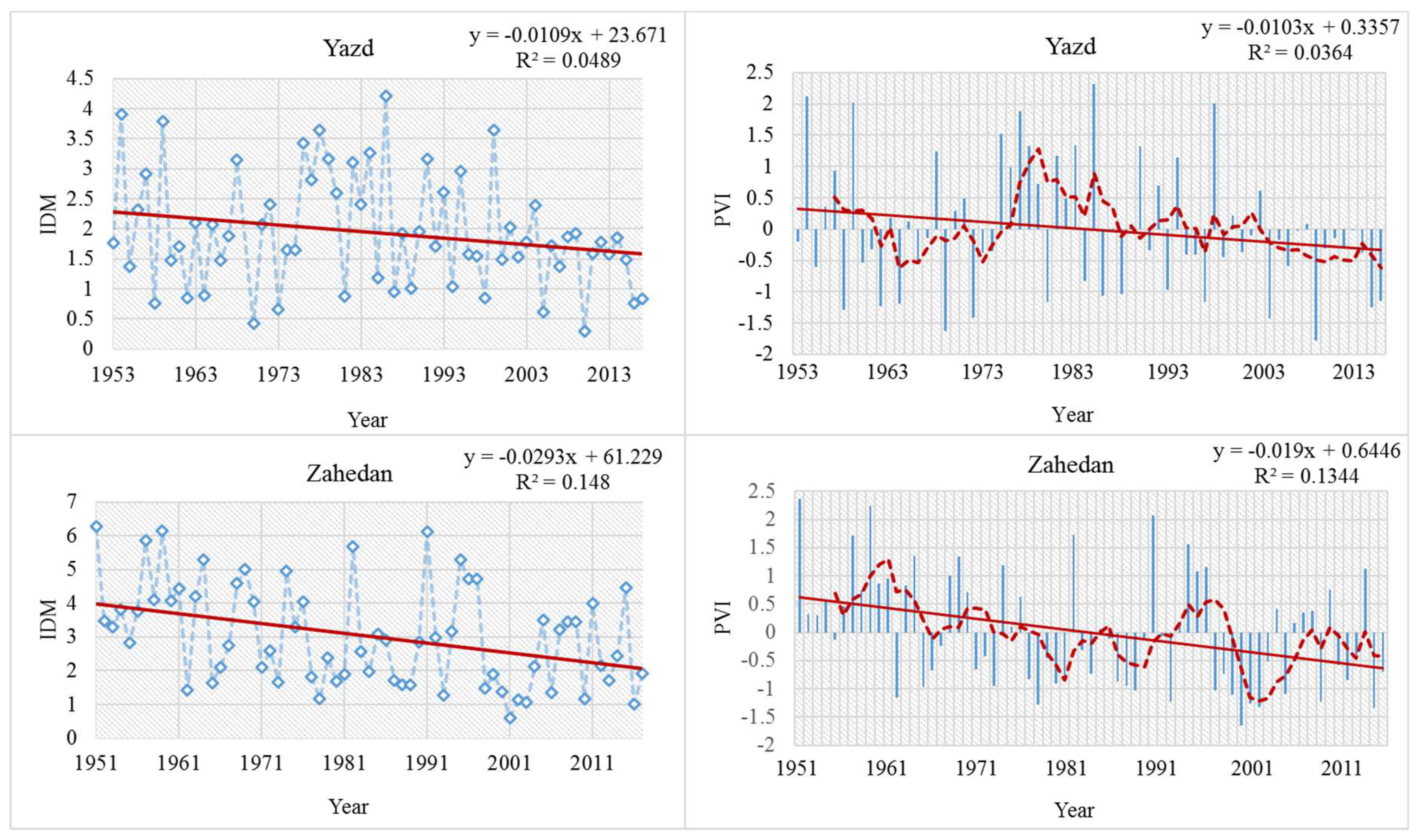

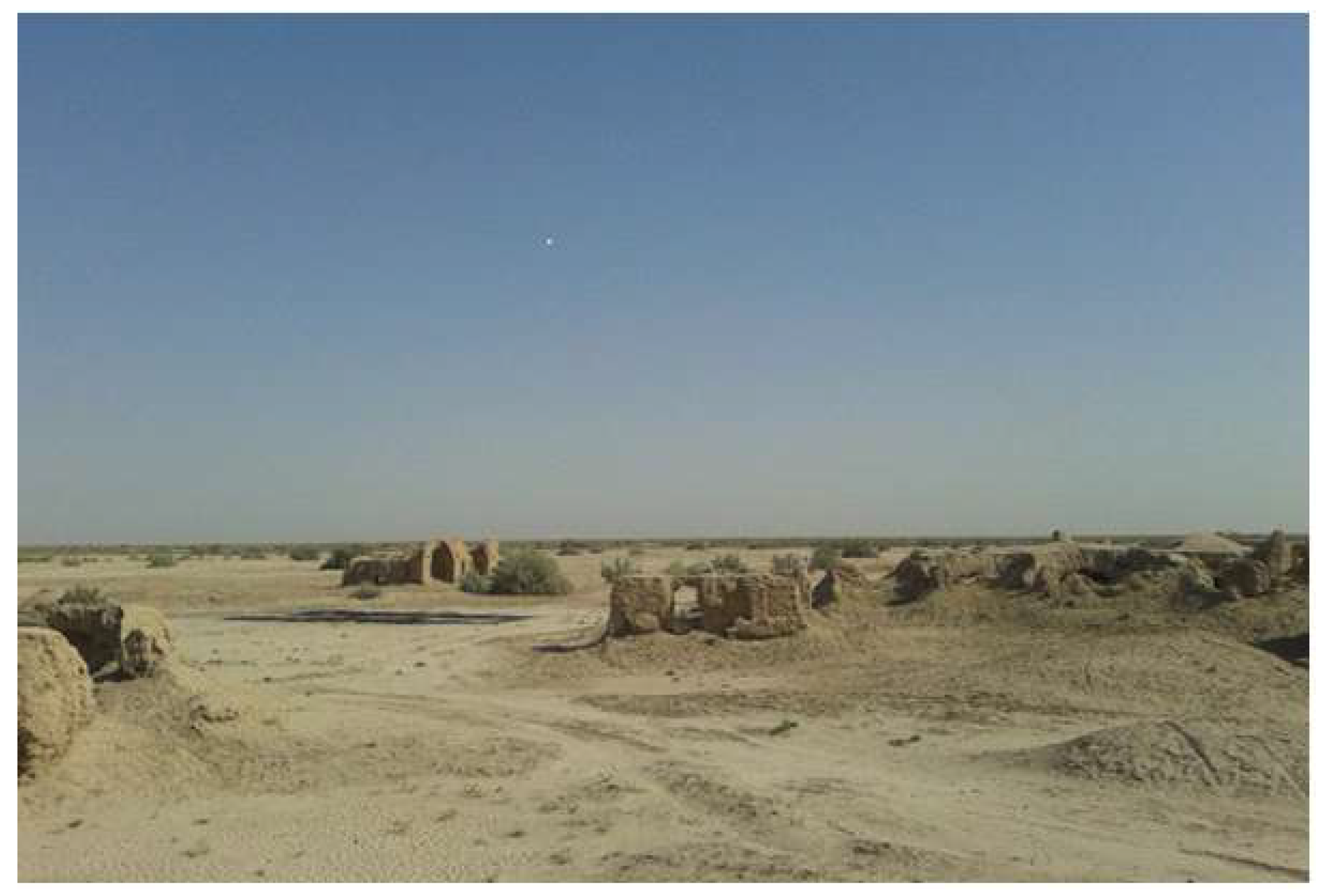
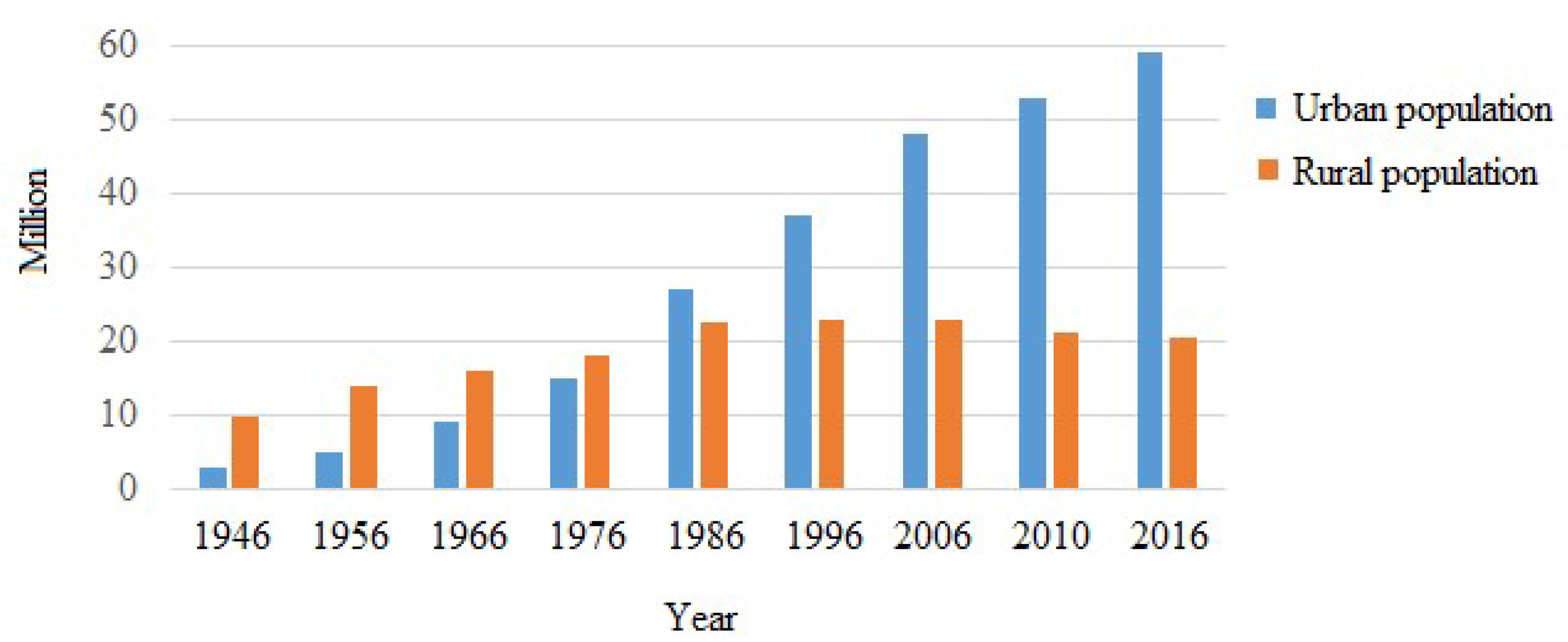
| Nr. | Station | Years | Latitude (N) | Longitude (E) | Elevation (m) a.s.l | Annual Precipitation (mm) | Annual Mean Temperature (°C) | IDM | Climate Type |
|---|---|---|---|---|---|---|---|---|---|
| 1 | Yazd | 1951–2017 | 31°54′ | 54°17′ | 1237 | 56.8 | 19.5 | 1.9 | Arid |
| 2 | Zahedan | 1951–2017 | 19°28′ | 60°53′ | 1370 | 86.7 | 18.8 | 3 | Arid |
| 3 | Iranshahr | 1965–2017 | 27°12′ | 60°42′ | 591 | 108.2 | 27.6 | 2.9 | Arid |
| 4 | Bushehr | 1986–2017 | 28°58′ | 50°49′ | 9 | 225 | 25 | 7.3 | Arid |
| 5 | Mashhad | 1951–2017 | 36°16′ | 59°38′ | 999 | 249.2 | 14.3 | 17.4 | Semi-arid |
| 6 | Ahvaz | 1957–2017 | 31°20′ | 48°40′ | 22.5 | 328 | 14 | 13.7 | Semi-arid |
| 7 | Shiraz | 1951–2017 | 24°32′ | 52°36′ | 1484 | 330.2 | 18.1 | 11.7 | Semi-arid |
| 8 | Arak | 1951–2017 | 34°06′ | 49°46′ | 1708 | 328.5 | 13.9 | 13.7 | Semi-arid |
| 9 | Orumiye | 1951–2017 | 37°40′ | 45°03′ | 1328 | 334 | 11.3 | 15.6 | Semi-arid |
| 10 | Kermanshah | 1951–2017 | 34°21′ | 47°09′ | 1318.6 | 431.4 | 14.8 | 17.4 | Semi-arid |
| 11 | Gorgan | 1960–2017 | 36°04′ | 54°24′ | 0 | 569 | 17.7 | 20.5 | Mediterranean |
| 12 | Rasht | 1956–2017 | 37°19′ | 49°37′ | −8.6 | 1334.2 | 16.2 | 51 | Very humid |
| Climate Type | IDM Values |
|---|---|
| Arid | IDM < 10 |
| Semi-arid | 10 ≤ IDM < 20 |
| Mediterranean | 20 ≤ IDM < 24 |
| Semi-humid | 24≤ IDM < 28 |
| Humid | 28 ≤ IDM < 35 |
| Very humid | 35 ≤ IDM < 55 |
| Extremely humid | IDM > 55 |
| Salinity Level | Irrigated Land (million ha) | dS/m |
|---|---|---|
| Slight | 0.9 | 4–8 |
| Moderate | 1.2 | 8–16 |
| Strong | 1.5 | 16–32 |
| Very strong | 1.1 | >32 |
| Total | 4.7 |
© 2019 by the authors. Licensee MDPI, Basel, Switzerland. This article is an open access article distributed under the terms and conditions of the Creative Commons Attribution (CC BY) license (http://creativecommons.org/licenses/by/4.0/).
Share and Cite
Emadodin, I.; Reinsch, T.; Taube, F. Drought and Desertification in Iran. Hydrology 2019, 6, 66. https://doi.org/10.3390/hydrology6030066
Emadodin I, Reinsch T, Taube F. Drought and Desertification in Iran. Hydrology. 2019; 6(3):66. https://doi.org/10.3390/hydrology6030066
Chicago/Turabian StyleEmadodin, Iraj, Thorsten Reinsch, and Friedhelm Taube. 2019. "Drought and Desertification in Iran" Hydrology 6, no. 3: 66. https://doi.org/10.3390/hydrology6030066
APA StyleEmadodin, I., Reinsch, T., & Taube, F. (2019). Drought and Desertification in Iran. Hydrology, 6(3), 66. https://doi.org/10.3390/hydrology6030066





